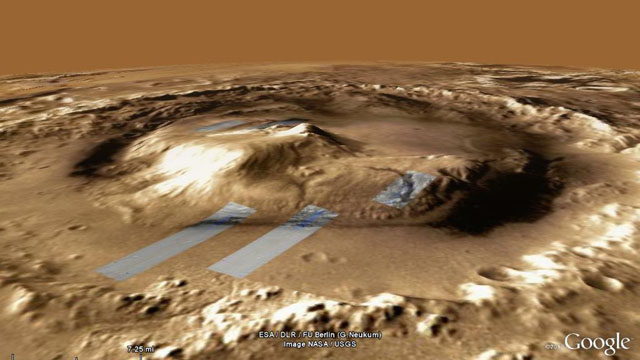My first Google-vista of Gale, which included several overlaid strips of high-resolution imagery from the Mars Reconnaissance Orbiter (MRO), hinted that there may be a LOT of interest here.
Gale Crater, about 90 miles across, sports a really large mountain right in the middle—mostly filling the bowl, in fact. The mountain, whose peak rises around 2700 feet above average Martian surface level (can’t say sea level there…not in the present day, at least), towers 3 miles above the deepest part of the crater surrounding it.
I zoomed in on an MRO overlay of a canyon high on the mountain, finding what looks like layered deposits exposed by whatever cutting action had carved the canyon in the past. The landscape I find there is stunning, the details rich. I almost feel as though I’ve stood where Curiosity is soon to tread.
The rover will be set down by a sort of rocket-propelled winch, lowered gently to the base of the mountain where an alluvial fan promises potential riches. Not wind-worn pebbles of solid gold, not fist-sized chunks of diamond—well, probably not—but rather the riches of dirt that may have been deposited there by the action of water. A dumpster of chemical, geological, and potentially biological history.
One of the reasons Gale Crater was chosen as Curiosity’s destination is that it is a deep, low-altitude impact crater, situated at a “downhill” destination where water, if indeed it did flow on Mars long ago, is very likely to have converged, dumping all sorts of soil, rock, and whatever else might have come along for the ride.
Curiosity carries ten instruments designed to conduct a range of measurements, including chemical analysis of soil and rock samples in search of organic compounds that may have been preserved. Where Curiosity’s predecessors, Spirit and Opportunity, have looked for the chemical signs of past water to help tell us whether Mars was ever hospital to life, Curiosity will look for the leftovers of life itself. And in the bottom-lands of Gale Crater, at the foot of a huge mountain from which the rubble of layer upon layer of history has been scoured, it will be in a really good place to do it.

